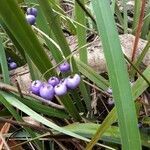A robust spreading lily. It keeps growing from year to year. It grows 0.5-1.5 m high and spreads 0.5-2 m wide. It forms tufts. The leaves are thick and shiny and strap like. The leaves can be 1.2 m long. They are 15-30 mm wide. They are keeled. The sheath at the base is reddish or purple. The flowers occur in loose clusters. They are on long branching stems and are blue. They are star like. The fruit are deep blue berries. They are 25 mm across. They contain many black seeds.

